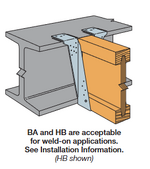I am supporting a hot tub on an elevated wood framed deck. The deck joist will be supported via a top flange hanger attached to a nailer on a steel beam. I wish I could bear the wood joist directly on top of the beam, but I cannot for architectural reasons. I am concerned about the top flange hanger rusting out and failing over time. I am specifying simpson model WP with HDG finish and Type 316 Stainless Steel nails in all holes.
Should I be concerned about this?
Should I be concerned about this?

